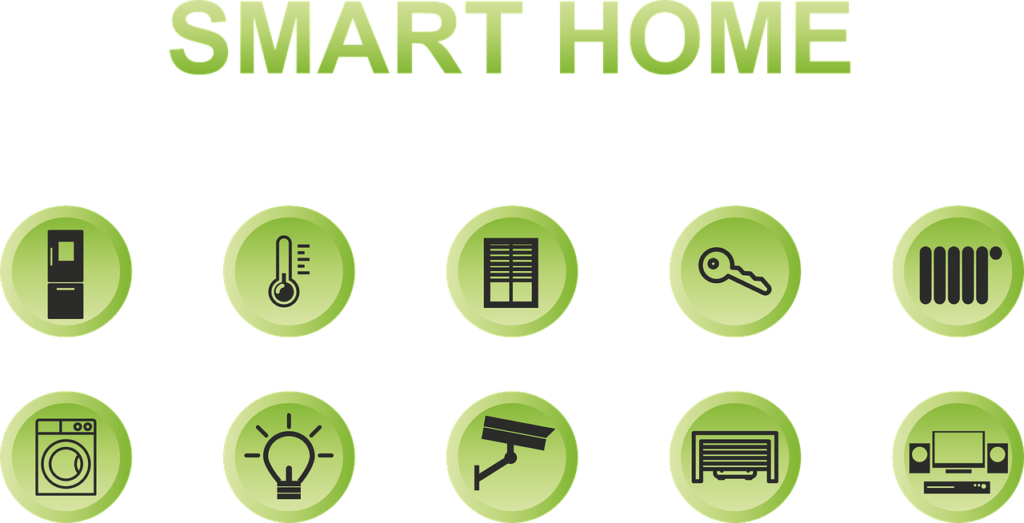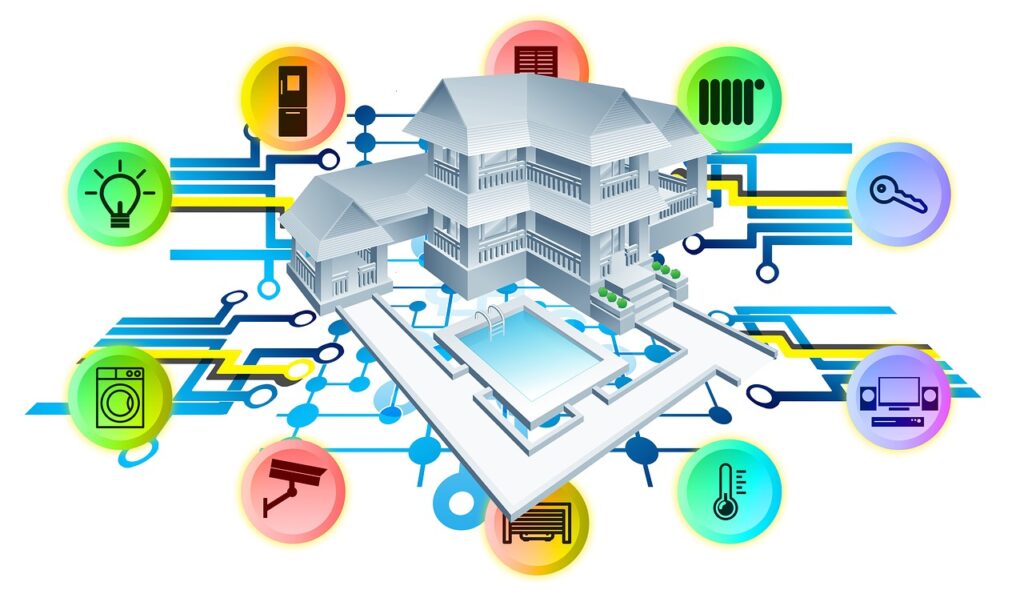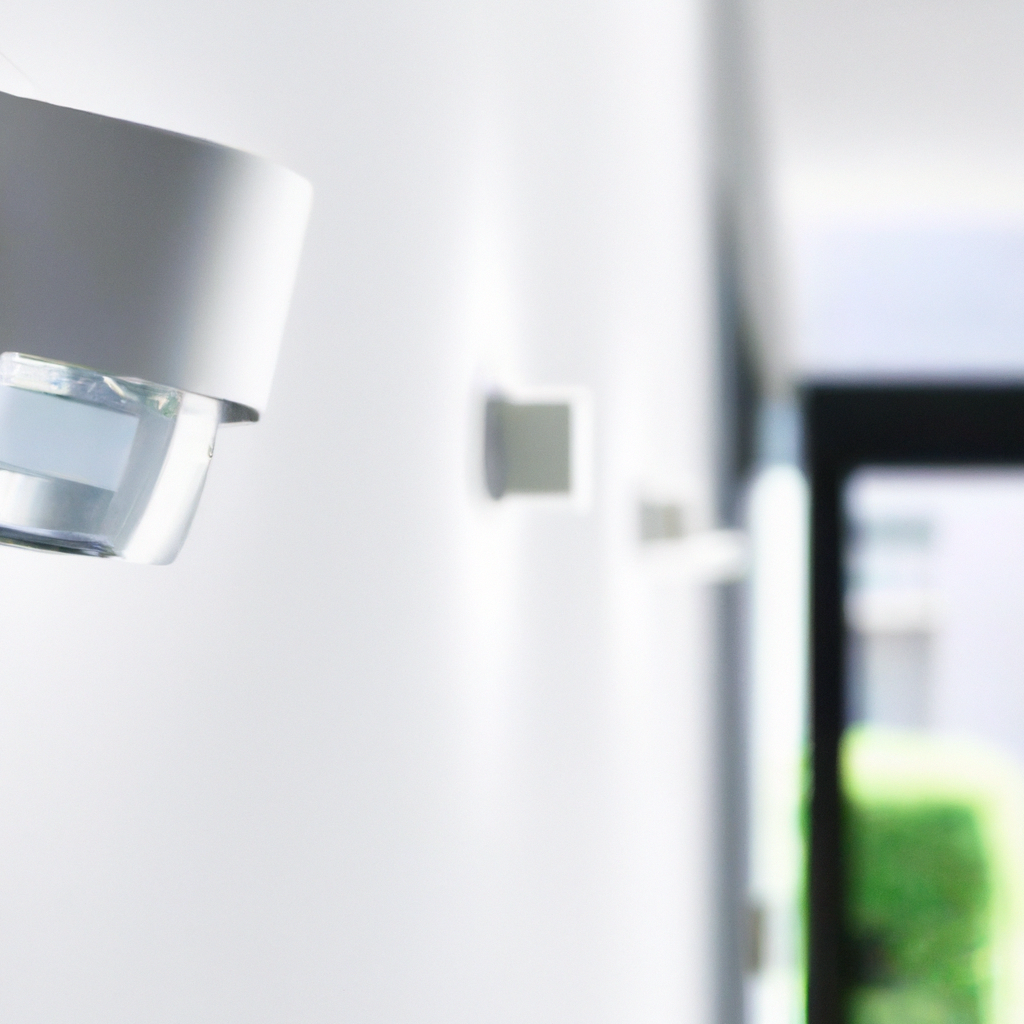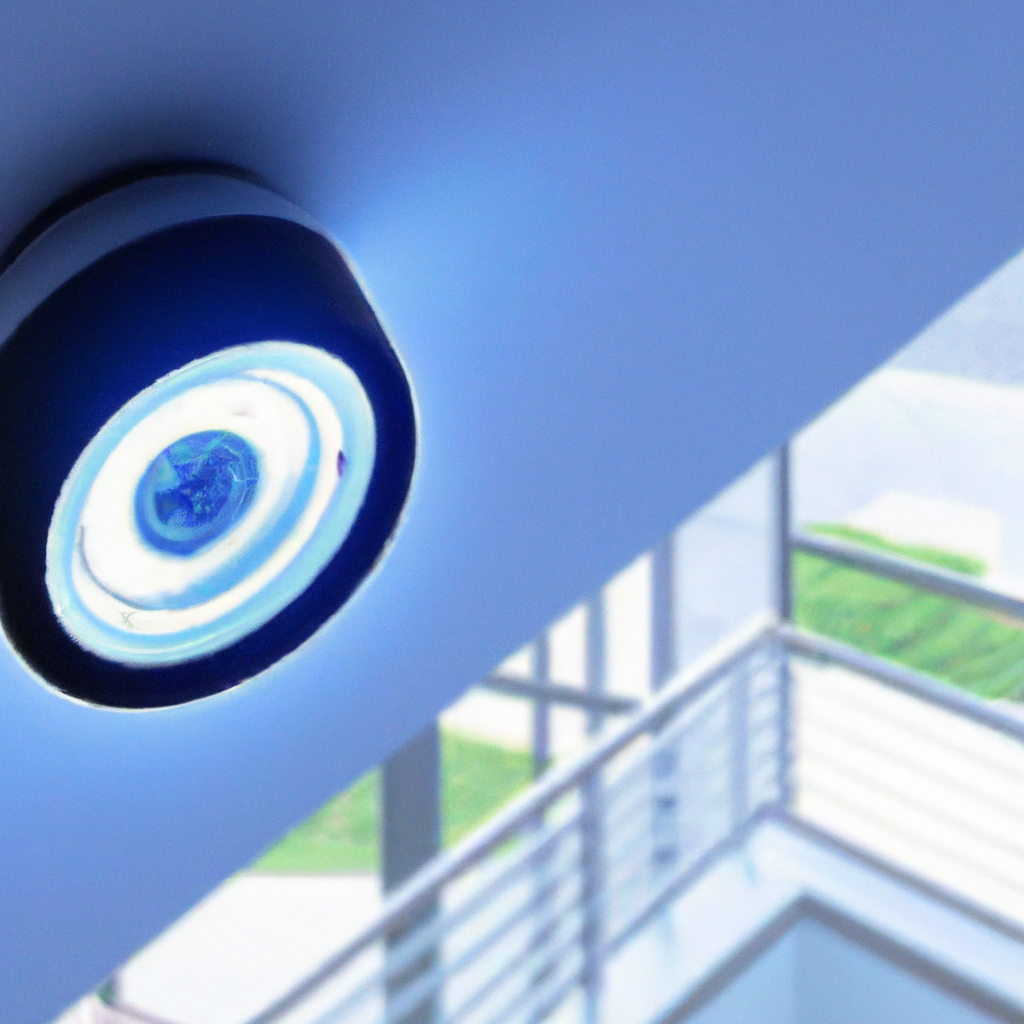Picture this: you’re peacefully settled in your cozy home, and suddenly, the sound of a creaking floorboard downstairs catches your attention. Your heart races, and with a sense of urgency, you scramble to turn on the lights. But what if your lights could anticipate your every move? In this article, we’ll uncover the fascinating synergy between motion sensors and smart lights for home security. Discover how these two technological marvels seamlessly collaborate to create an environment where safety and convenience effortlessly intertwine.

Motion Sensors
Types of Motion Sensors
There are several types of motion sensors commonly used in home security systems. These include passive infrared (PIR) sensors, microwave sensors, ultrasonic sensors, and dual-technology sensors.
- Passive infrared sensors detect changes in infrared radiation caused by the movement of warm objects, such as humans or animals. These sensors are the most commonly used in residential applications due to their effectiveness and affordability.
- Microwave sensors emit microwave pulses and measure the reflections of these pulses to detect motion. They are highly sensitive and can detect even slight movements but are more expensive than PIR sensors.
- Ultrasonic sensors emit high-frequency sound waves and detect changes in the frequency caused by moving objects. They are suitable for detecting motion in large areas but can be affected by environmental factors such as temperature and humidity.
- Dual-technology sensors combine two different types of sensors, typically PIR and microwave, to reduce false alarms. By requiring both sensors to detect motion, they provide a higher level of accuracy.
How Motion Sensors Work
Motion sensors operate by detecting changes in their surrounding environment. When motion is detected, the sensor sends a signal to a control panel or a hub, which then triggers the desired action, such as turning on the lights or activating an alarm.
PIR sensors, for example, contain a specially designed sensor that responds to the infrared energy emitted by warm objects. When a person or an animal moves within the sensor’s range, the energy pattern changes, and the sensor sends a signal to the control panel. This signal is then used to initiate the programmed action, such as illuminating the area with smart lights.
Microwave sensors work by emitting microwave pulses and measuring the reflections caused by moving objects. Any change in the reflected microwave signals triggers the sensor, indicating motion. These sensors are more sensitive than PIR sensors but can be affected by environmental factors.
Ultrasonic sensors emit high-frequency sound waves and analyze the frequency of the returning waves. When the frequency changes due to the movement of an object, the sensor registers it as motion and sends a signal. Dual-technology sensors combine the features of PIR and microwave sensors for enhanced accuracy. They require both sensors to detect motion before triggering a response.
Smart Lights
Features of Smart Lights
Smart lights are an integral part of many home security systems. These advanced lighting solutions offer a range of features that enhance security and convenience.
- Remote Control: Smart lights can be controlled remotely through mobile apps or home automation systems. This allows you to turn your lights on or off from anywhere, providing the appearance of an occupied home even when you’re away.
- Scheduling: With smart lights, you can program specific schedules for them to turn on and off automatically. This not only adds convenience but can also deter potential intruders by creating the illusion of an occupied home.
- Motion Activation: Smart lights equipped with motion sensors can automatically turn on when they detect movement in their vicinity. This provides extra security by illuminating dark areas and signaling that someone may be present.
- Dimming and Color Control: Some smart lights offer the ability to adjust brightness levels and even change colors. This feature can be utilized to create different lighting setups for various situations, enhancing both security and ambiance.
- Integration with Other Devices: Smart lights can be integrated with other devices and systems such as motion sensors, security cameras, or voice assistants to create a comprehensive home security ecosystem.
How Smart Lights Work
Smart lights are equipped with wireless communication capabilities, typically using Wi-Fi or Zigbee technology, which allows them to connect to a central hub or home automation system. This hub acts as a control center, enabling you to manage and control your smart lights through mobile apps, voice commands, or programmed schedules.
When a command is given, such as turning on the lights or adjusting the brightness, the control hub sends a signal to the respective smart lights. These lights are equipped with receivers that receive the signal and perform the requested action. In the case of motion-activated smart lights, the integrated motion sensor detects movement and triggers the lights to turn on automatically.
Smart lights also have built-in memory capabilities, allowing them to remember programmed schedules and preferences. This ensures that even during internet outages or temporary disconnections, the lights can continue to operate according to their predefined settings.
Integration of Motion Sensors and Smart Lights
Benefits of Integrating Motion Sensors and Smart Lights
Integrating motion sensors with smart lights can significantly enhance home security and provide numerous benefits.
- Increased Alertness: By combining motion sensors and smart lights, you can create an active security system that responds to any detected movement. The lights turn on automatically, alerting you and potentially deterring intruders.
- Energy Efficiency: Motion-activated smart lights only illuminate when there is motion detected, resulting in energy savings. With proper placement and programming, you can minimize unnecessary lighting and reduce electricity consumption.
- Convenience: Integrating motion sensors with smart lights eliminates the need to manually control the lights. They automatically respond to movement, ensuring you don’t have to fumble for light switches in the dark.
- Customization: With the integration of motion sensors and smart lights, you can customize the sensitivity and behavior of the lights according to your preferences. This flexibility allows you to create a tailored security system that suits your specific needs.
- Cost-Effective Solution: Motion sensors and smart lights are relatively affordable and offer a cost-effective alternative to more complex security systems. They provide an added layer of protection without requiring extensive installation or maintenance.
Choosing Compatible Devices
When integrating motion sensors and smart lights, it is essential to select devices that are compatible and designed to work together. Consider the following factors when choosing compatible devices:
- Communication Protocol: Ensure that the motion sensors and smart lights use the same communication protocol, such as Zigbee or Z-Wave, to ensure seamless integration.
- System Compatibility: Check if the devices are compatible with your existing home automation system or hub. This will allow you to control and manage them through a centralized interface.
- Range and Coverage: Consider the range and coverage area of both the motion sensors and smart lights. Ensure that the sensors can detect motion in the desired areas and that the lights can effectively illuminate those areas.
- Functionality and Features: Evaluate the features and functionality of both the motion sensors and smart lights to determine if they meet your specific requirements. Consider factors such as motion detection range, sensitivity adjustment, and the ability to create custom lighting schedules.
By carefully selecting and integrating compatible motion sensors and smart lights, you can create a seamless and effective home security system.
Designing an Effective Home Security System
Determining Sensor Placement
Proper sensor placement is crucial for maximizing the effectiveness of your motion sensors. Consider the following tips when determining sensor placement:
- Entry Points: Place motion sensors near entry points such as doors, windows, and garage entrances. This ensures that any unauthorized movement near these areas triggers the sensors and activates the smart lights.
- Hallways and Staircases: Install motion sensors in hallways and staircases to provide visibility in high-traffic areas. This helps prevent accidents and enhances security by illuminating potential escape routes for intruders.
- Common Areas: Place motion sensors in common areas such as living rooms or kitchens to ensure coverage for the most frequently used spaces in your home.
- Exterior Areas: Consider installing motion sensors in exterior areas, such as patios or driveways, to detect any movement outside your home. Integrated with smart lights, they can serve as an effective deterrent to potential intruders.
Programming Smart Lights
While motion sensors detect movement, smart lights provide the necessary illumination. Programming smart lights in conjunction with motion sensors is crucial for an effective home security system. Consider the following when programming your smart lights:
- Motion Sensitivity: Adjust the sensitivity of your motion sensors to avoid false triggers caused by pets or small movements. Fine-tuning the sensitivity ensures that the lights respond accurately to potential security concerns.
- Lighting Duration: Determine how long your smart lights should remain illuminated after detecting motion. Balance the need for extended visibility with energy efficiency considerations.
- Timing and Scheduling: Set up specific schedules for your smart lights to turn on and off automatically. This creates the illusion of an occupied home, enhancing security when you are away.
- Integration with Other Devices: Explore options for integrating your smart lights with other devices, such as security cameras or voice assistants. This integration allows for seamless automation and further enhances your home security system.
By carefully designing and programming your home security system, you can create an effective solution that deters intruders and enhances the safety of your home.

Enhancing Home Security with Motion Sensors and Smart Lights
Deterring Intruders
Motion sensors and smart lights work together to deter potential intruders by creating an active and responsive security system. The sudden illumination of lights when motion is detected can startle and discourage unauthorized individuals from proceeding further. Brightly lit areas also provide better visibility, reducing hiding spots and making your home less appealing to potential burglars.
To maximize the deterrent effect, strategically place motion sensors and smart lights at entry points, dark corners, and areas with limited visibility. By ensuring comprehensive coverage, you create an environment that discourages unauthorized access and provides peace of mind for you and your family.
Automated Lighting Control
One of the key benefits of integrating motion sensors and smart lights is the ability to automate lighting control. Instead of manually turning on lights, motion sensors can activate the smart lights as soon as movement is detected. This automation eliminates the need to fumble for light switches in the dark, enhancing convenience and safety.
Automated lighting control is particularly beneficial when entering or leaving your home at night. As you approach your front door, the motion sensor detects your movement and automatically lights up the porch and entryway, providing a well-lit path and reducing the risk of accidents or potential threats.
Integration with Other Security Devices
Alarm Systems
Integrating motion sensors and smart lights with alarm systems can provide a more comprehensive and robust home security solution. When the motion sensors detect movement, they can trigger not only the smart lights but also the alarm system, alerting you and scaring off potential intruders.
By integrating these devices, you create a multi-layered security system that combines detection, illumination, and audible warnings. This can significantly improve the effectiveness of your home security efforts, providing you with added peace of mind.
Surveillance Cameras
Motion sensors can also be integrated with surveillance cameras to enhance home security. When motion is detected, the sensors can trigger the cameras to start recording, ensuring that any suspicious activity is captured as evidence.
By connecting motion sensors, smart lights, and surveillance cameras, you create a comprehensive security ecosystem. The motion sensors detect movement, the smart lights illuminate the area, and the surveillance cameras record the event, providing a holistic approach to home security.

Energy Efficiency Considerations
Motion Sensors for Lighting Control
Motion sensors offer significant energy-saving benefits when used for lighting control. By automatically turning on lights only when needed, motion sensors eliminate unnecessary lighting and reduce electricity consumption.
Traditional lighting systems often rely on occupants manually turning lights on and forgetting to turn them off when leaving a room. This leads to wasted energy and higher electricity bills. With motion sensors, lights are only active when there is movement, resulting in energy efficiency and cost savings.
To ensure optimal energy efficiency, strategically place motion sensors in areas with frequent usage, such as hallways or rooms where occupants tend to forget turning lights off. By doing so, you can eliminate the need for constant manual control and rely on the sensors to manage lighting based on occupancy.
LED Lighting Benefits
LED (light-emitting diode) lighting is an ideal choice for smart lights integrated with motion sensors due to its energy efficiency and longevity. Compared to traditional incandescent bulbs, LED lights consume far less energy and have a longer lifespan.
LED lights also provide excellent brightness and illumination, making them an ideal choice for security lighting. When integrated with motion sensors, LEDs can deliver instant and reliable illumination whenever motion is detected, ensuring maximum visibility and safety.
In addition to energy efficiency, LED lights are also highly customizable in terms of color temperature and brightness control. This flexibility allows you to create different lighting atmospheres for various scenarios, enhancing both security and ambiance in your home.
Smart Lighting Solutions for Different Areas
Outdoor Security Lighting
Outdoor security lighting plays a critical role in deterring potential intruders and enhancing the safety of your property. By integrating motion sensors and smart lights, you can create a robust outdoor security lighting system that provides enhanced visibility when needed.
Place motion sensors strategically around your property, focusing on entry points, pathways, and areas with limited visibility. When motion is detected, the smart lights will illuminate the area, ensuring that potential threats are easily detected and discouraged.
Consider using weather-resistant and durable smart lights designed for outdoor use. These lights can withstand various weather conditions and provide reliable performance year-round, enhancing the security and aesthetics of your outdoor spaces.
Indoor Security Lighting
Indoor security lighting is just as important as outdoor lighting when it comes to home security. By integrating motion sensors and smart lights indoors, you can create an environment that responds to movement and provides optimal visibility.
In high-traffic areas such as hallways or staircases, install motion sensors that activate smart lights as soon as movement is detected. This ensures that occupants have a well-lit pathway, reducing the risk of accidents and making it less appealing for potential intruders to enter your home undetected.
Consider using smart lights with adjustable brightness levels to create comfortable illumination throughout your living spaces. Dimmable lights allow you to customize the lighting intensity based on preferences or time of day, creating a safe and inviting environment at all times.

Smart Home Integration
Connecting to Home Automation Systems
To fully leverage the capabilities of motion sensors and smart lights, integrating them with a home automation system offers enhanced control and convenience. Home automation systems act as a centralized hub, allowing you to manage and control various smart devices, including motion sensors and smart lights.
Connecting motion sensors and smart lights to a home automation system enables seamless control through mobile apps or voice assistants. You can configure advanced automation rules, such as turning on specific lights when specific motion sensors detect movement, or creating custom lighting scenes based on time of day or occupancy.
Home automation systems also provide integration with other security devices, such as surveillance cameras or alarm systems. With a unified platform, you can monitor and manage all aspects of your home security from a single interface, maximizing convenience and efficiency.
Voice Control and Mobile Apps
Motion sensors and smart lights can be controlled via voice commands through voice assistants such as Amazon Alexa or Google Assistant. By simply speaking commands, you can turn lights on or off, adjust brightness levels, or create custom lighting scenes.
Mobile apps dedicated to managing smart lights and motion sensors offer additional control and convenience. Through these apps, you can remotely access and control your smart lights from anywhere, ensuring that your home remains well-lit and secure, even when you’re away.
Voice control and mobile apps provide flexible and intuitive control over your smart lights and motion sensors, making it easy for you to manage and customize your home security system according to your preferences.
Installation and Maintenance
Mounting and Wiring Motion Sensors
Proper installation of motion sensors is essential for their optimal functioning. Follow these guidelines when mounting and wiring motion sensors:
- Mounting Height: Install motion sensors at a suitable height to maximize their coverage area and avoid false triggers caused by pets or small movements. Typically, a height of 6-8 feet above the ground is recommended for most scenarios.
- Angle and Positioning: Aim motion sensors towards the desired detection area, adjusting their angle and positioning as needed. Consider the range and coverage area of the sensors to ensure they effectively detect motion in the specified zones.
- Wiring Considerations: If the motion sensors require wiring, ensure that you follow the manufacturer’s instructions and adhere to local electrical codes. Properly secure and route the wires, ensuring they are protected from damage and interference.
- Power Source: Determine the power source for your motion sensors, which may include batteries or electrical wiring. Ensure that the power source is reliable and provides consistent power to the sensors.
Proper installation of motion sensors is crucial for their accurate detection capabilities. By following these guidelines, you can ensure that the motion sensors are positioned correctly for optimal performance.
Routine Check-ups and Troubleshooting
Regular check-ups and maintenance are essential to ensure the continued effectiveness of your motion sensors and smart lights. Follow these tips for routine check-ups and troubleshooting:
- Test Sensors: Periodically test the functionality of your motion sensors by intentionally triggering them and ensuring they activate the desired actions, such as turning on the smart lights.
- Clean Sensors: Keep the sensors clean and free from dirt or debris that may hinder their performance. This can be done using a soft cloth or a compressed air canister.
- Check Batteries: If your motion sensors are battery-powered, replace the batteries regularly or as recommended by the manufacturer. Weak batteries can cause unreliable detection and false triggers.
- Monitor Connectivity: Ensure that your motion sensors and smart lights remain connected to the control hub or home automation system. Check for any connectivity issues and troubleshoot as necessary.
- Update Firmware: If firmware updates are available for your motion sensors or smart lights, install them to ensure you have the latest features, improvements, and security patches.
By performing routine check-ups and troubleshooting, you can identify and resolve any issues promptly, ensuring that your home security system functions optimally.
In conclusion, motion sensors and smart lights work together seamlessly to enhance home security. Motion sensors detect movement and trigger the activation of smart lights, providing increased visibility and deterring potential intruders. By integrating these devices, you can create an effective and energy-efficient home security system that offers convenience and peace of mind. Proper design, installation, and maintenance are crucial for the optimal performance of motion sensors and smart lights, ensuring that your home remains safe and well-illuminated.











